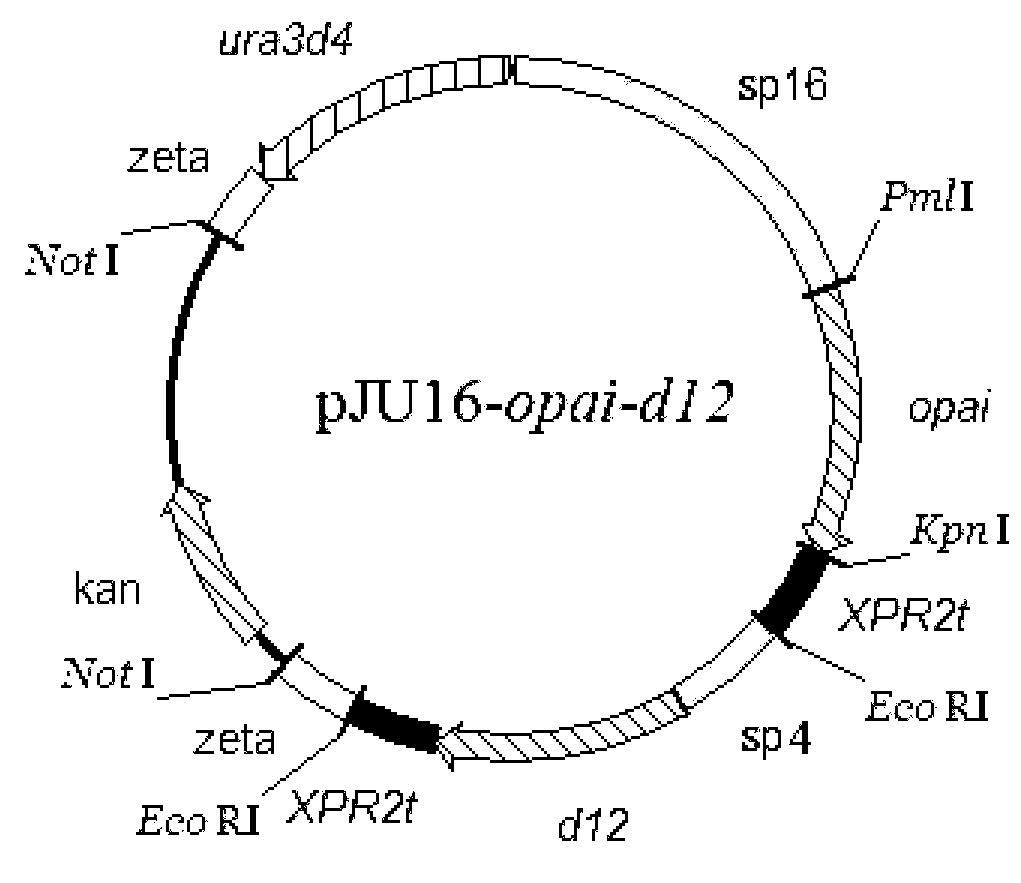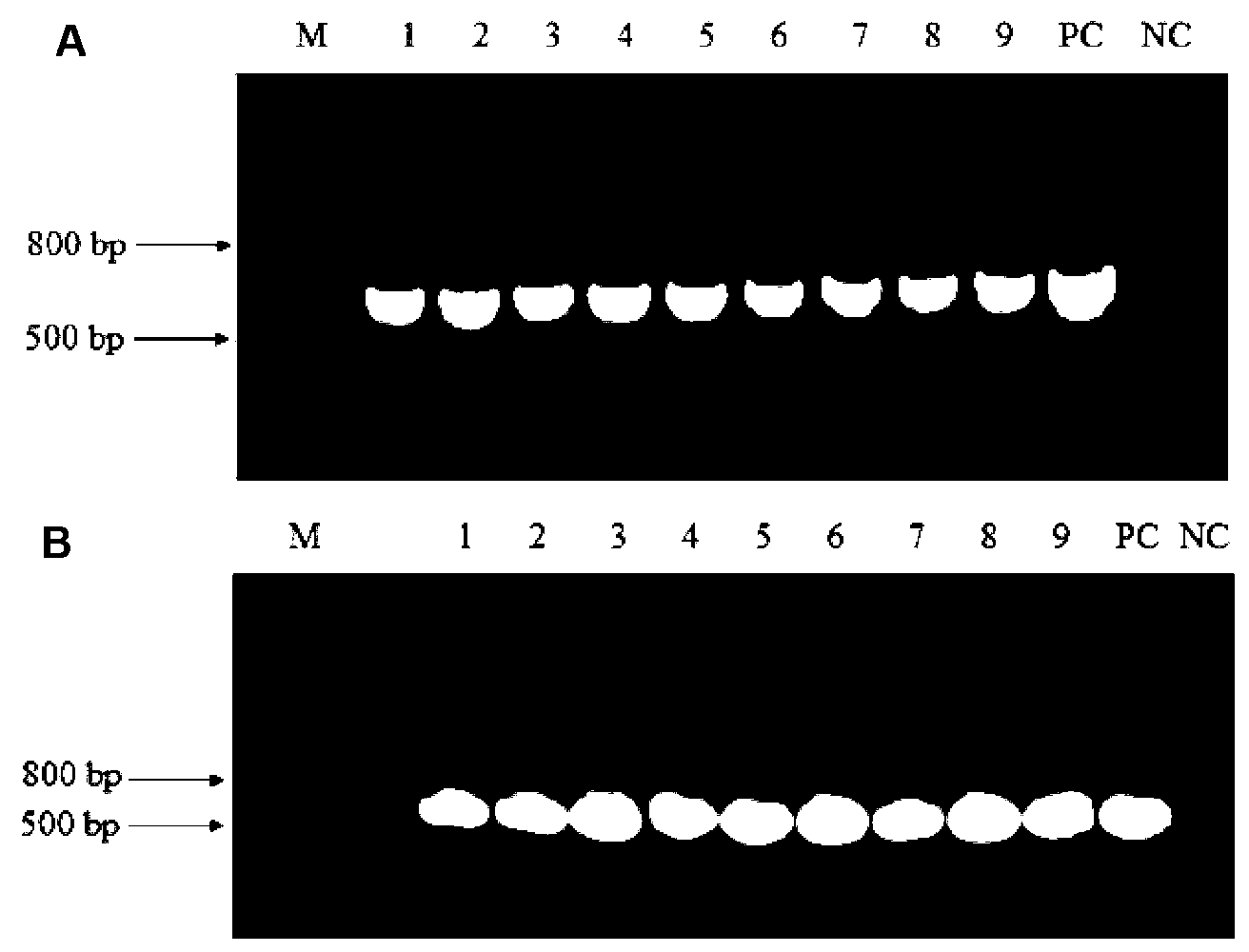Method for optimizing conjugated linoleic acid synthesis by using Yarrowia lipolytica yeast recombinant strain based on genetic engineering strategy
A conjugated linoleic acid and yeast technology is applied in the field of further optimization of recombinant Yarrowia lipolytica strains for synthesizing conjugated linoleic acid, and can solve problems such as insufficient yield
- Summary
- Abstract
- Description
- Claims
- Application Information
AI Technical Summary
Problems solved by technology
Method used
Image
Examples
Embodiment 1
[0026] Example 1. Construction of recombinant expression plasmids
[0027] Primers P1 / P2 (see Table 1) were designed according to the sequence of the delta-12 desaturase gene (FADS12, d12, whose nucleotide sequence is shown in SEQ ID NO: 2) in the Genbank database, and the mRNA of M.alpine ATCC32222 was extracted and reversed. It was transcribed into cDNA, and the cDNA was used as a template to amplify the d12 gene by PCR, and the two ends of the gene were connected with PmlI and KpnI restriction sites. The PCR program is: 94°C for 15s, 58°C for 30s, 68°C for 1min, 30 cycles. The amplified fragment was connected to the T vector pMD19T (purchased from TaKaRa Company) to obtain pMD19T-d12. The optimized opai gene (its nucleotide sequence is shown in SEQ ID NO: 1) was synthesized by Nanjing GenScript Biotechnology Co., Ltd., and subcloned into the vector pUC57 (purchased from Nanjing GenScript Biotechnology Co., Ltd. company) to obtain pUC57-opai. Design primers P3 / P4 accordin...
Embodiment 2
[0029] Example 2. Construction of recombinant Yarrowia lipolytica
[0030] After the recombinant plasmid pJU16-opai-d12 was digested by Not I at 37°C for 1.5h, the expression unit fragment with the target gene was separated and recovered by 1% agarose gel electrophoresis, concentrated to 500ng / μl, and 2μg was used for transformation into Yarrowia lipolysis Yeast CCFM-JUL. The conversion process is as follows:
[0031] 1) Strain Y.lipolyticaCCFM-JUL was streaked on YPD solid medium and cultured at 28°C for 12h;
[0032] 2) Pick a loop of CCFM-JUL from the plate with an inoculation loop and resuspend it in 1mLTE solution;
[0033] 3) Centrifuge at 10,000 rpm to collect the bacteria, suspend the bacteria in 600 μl of 0.1 mol / 1 lithium acetate (pH6.0) buffer solution, and bathe in water at 28°C for 1 hour, be careful not to shake the sample;
[0034] 4) After the water bath is over, centrifuge at 3000rpm for 2min, discard the supernatant;
[0035] 5) Gently resuspend the bacte...
Embodiment 3
[0041] Example 3. Copy number analysis of expression units in multi-copy integrated strains
[0042] According to the ura3 and suc2 genes of Y.lipolytica in GenBank (see Dheepak M, Robyn R, Rajesh L, Clinton S, Robin M, Johann G, Santosh R. (2008).Multi-copy expression and fed- batch production of Rhodotourla araucariae epoxy hydrolase in Yarrowia lipolytica. Appl Microbiol Biotechnol, 79:235-244) sequence design of upstream and downstream primers P9 / P10 and P11 / P12 (see Table 1). The 20 μL PCR reaction system contains 10 μL of SYBR GREEN2×PCR Master Mix, 5 μL (30ng) of DNA template, and 5 μL (1 μmol / L) of upstream and downstream primers. The program is 95°C for 5min, 95°C for 15s, 60°C for 1min, 40 cycles. ABI7500 sequence detection system software was used for data analysis, and the expression of SUC2 gene was used as an internal reference, and the copy number of URA3 gene was quantified by the amplification cycle method (Ct method). The copy numbers of the expression unit...
PUM
 Login to View More
Login to View More Abstract
Description
Claims
Application Information
 Login to View More
Login to View More - R&D
- Intellectual Property
- Life Sciences
- Materials
- Tech Scout
- Unparalleled Data Quality
- Higher Quality Content
- 60% Fewer Hallucinations
Browse by: Latest US Patents, China's latest patents, Technical Efficacy Thesaurus, Application Domain, Technology Topic, Popular Technical Reports.
© 2025 PatSnap. All rights reserved.Legal|Privacy policy|Modern Slavery Act Transparency Statement|Sitemap|About US| Contact US: help@patsnap.com



